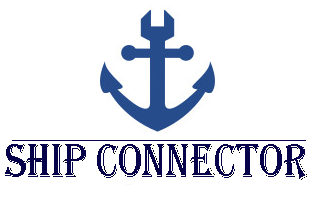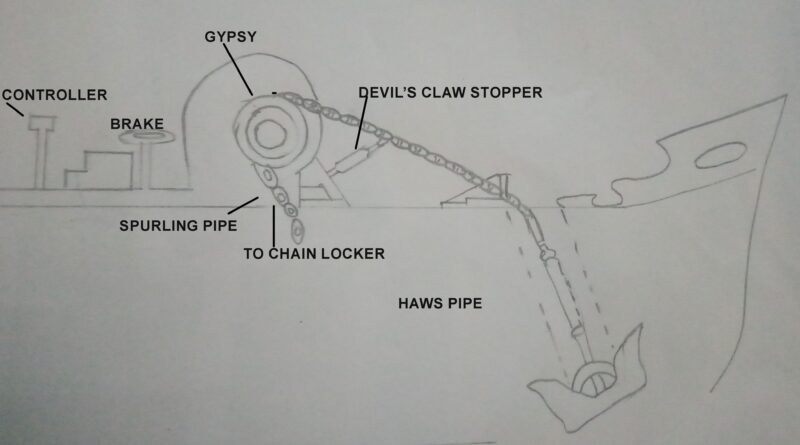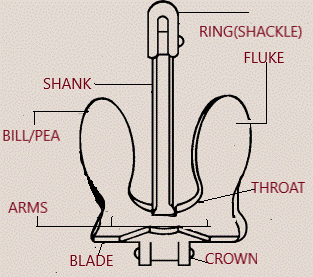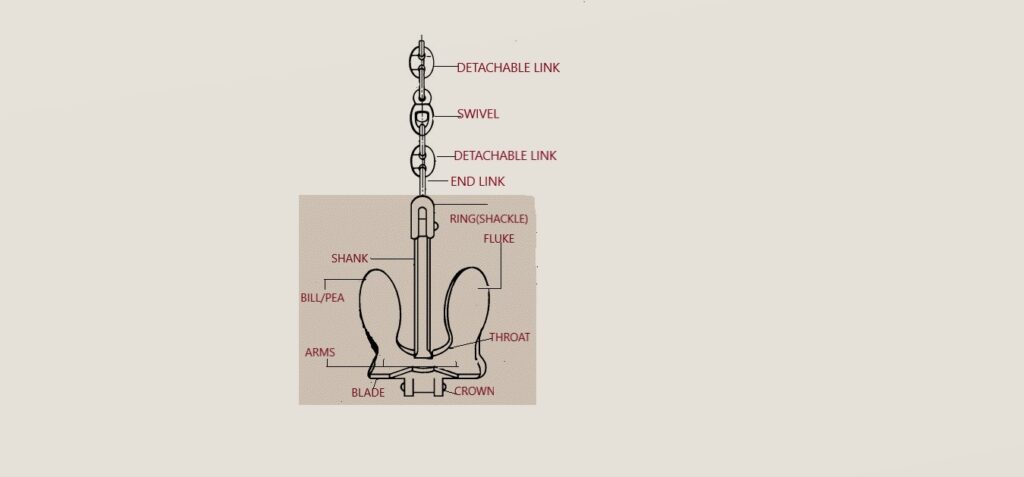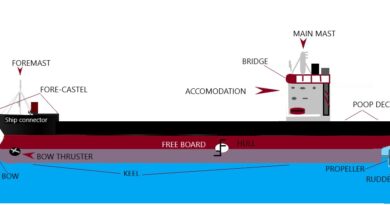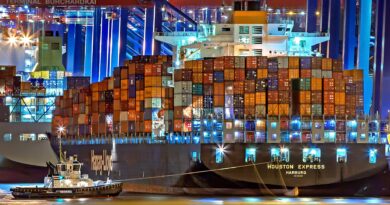Anchoring a ship
Contents
Anchoring a ship (An ultimate Guide)
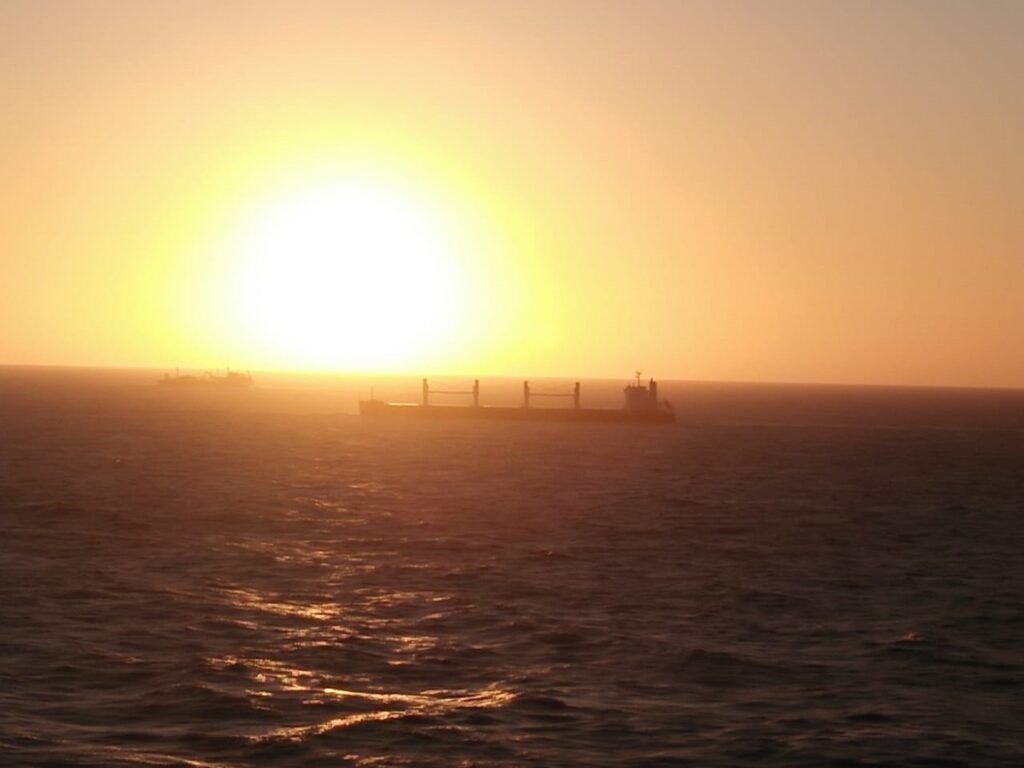
When a ship arrives near a port area, it may needed to anchor the ship.
The reason being there me congestion in the port,non availability of berth,some times ship may have to undergo customs clearance,immigration and cargo survey etc.
Another reason are
Receiving stores
provisions
Bunkers
Crew change
On hire/off hire surveys
Ship repairs
Waiting for port clearance etc.
Function of an Anchor
The function of an Anchor is to hold the ship from drifting away due to swell or underwater current, when an anchor is dropped, the anchor’s crown hits the sea bottom first.
As the master gives dead slow stern movement, the ship moves back, the flukes take its position then and embed itself into the seabed.
Chief officer or Duty officer who is present in the Anchor station will confirm that the good tension has been sighted on the chain, then after observing for some time about ships’ position master will ask duty officer to mark the position of dropping anchor
Anchor Chain Stay
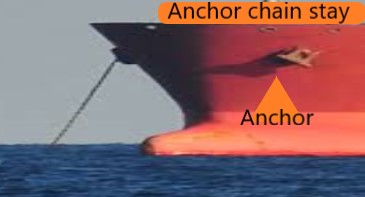
Chain Stay
The stay of the chain is to be reported by the Duty Officer as stay of the chain is the tendency of its movement.
Long stay: When the anchor cable is leading long with weight on it
Medium stay: When the anchor cable is leading medium
Short Stay: When the anchor is hove in close to the ship’s side and not extended long, also the cable is not up and down.
Up and Down – When the anchor chain is sighted vertically leading to the ship’s side.
Anchor Aweigh: The anchor is said to be Aweigh as soon as anchor fluke is out of the seabed and is clear of the sea bed.
Anchor Dragging: The anchor is said to be dragging when it do not hold to the sea bed.
After the anchor is let go ,the chain needs to be stretched out for the anchor to hold the vessel, the chain stay will be longer.
One can know if anchor is holding or not: the chain gets settle down and the stay on chain will change from medium to short stay finally the chain will seen up and down which is an indication of anchor holding and the chain is now settled down
Reporting anchor position
Reporting
The duty officer at the time of anchor operations acts as an eye to the Master ,as Master is present in Bridge he cannot see anchor position so every single status of the operation should be reported to the Master.
Most important points to report are:-
1.Anchor position
Chain position plays an important role to know if anchor is holding or not.
a. Clock format – The positions on starboard side will be 1’o clock to 5’o clock etc. and port side will start from 11 O’clock to 7′o clock
b. Cardinal Points – Reporting using the points system with starboard divided in 8 points and port side divided in 8 points as well. Example – 2 points on starboard bow or 4 points on port bow.
2.Chain stay
Long stay ,medium stay , short stay.
Safety precautions during anchoring
1. Proper use of PPE kit including safety helmet, hand gloves,safety Goggles, and ear muffs.
2. Leaning over the ship’s side while checking the anchor and its chain must be avoided, good position from where anchor can be seen must be find out.
3. Crew must stay clear from the windlass during letting go,many of times most of the accidents has been reported at the time of letting go anchor.
4.Sudden and repeated alteration of the speed of windlass must be avoided.
5.No matter how much urgency is their crew and officer must not come under pressure or panic and must tackle the situation with patience and nerve.
Anchor Chain
The chain length fitted with anchor will depend on the size of the ship.
A 15000 Dwt vessel would generally have 10 shackles.
A 350000 Dwt vessel may have upto 15 shackles
(1 shackles=15 fathoms=27.4 m).
BITTER END-
Bitter end is the one end of the chain which is secured in the chain locker, the other end is attached with a `D’ type shackle attached.
The bitter end is also connected with a shackle and secured to the bulkhead in any emergency it can be released quickly to let go the whole anchor chain or when there is requirement to repair or paint chain in dry dock.
It can be taken fully out from chain locker.

Marking the anchor cable
Cable markings
The Anchor chain is marked with paint and seizing wire to make it easy to know how much exact length of anchor chain is lowered in water.
The chain is marked at each joining shackle with paint and seizing wire.
First shackle – the first shackle is marked by seizing wire on the first studded link on both sides of the shackle.
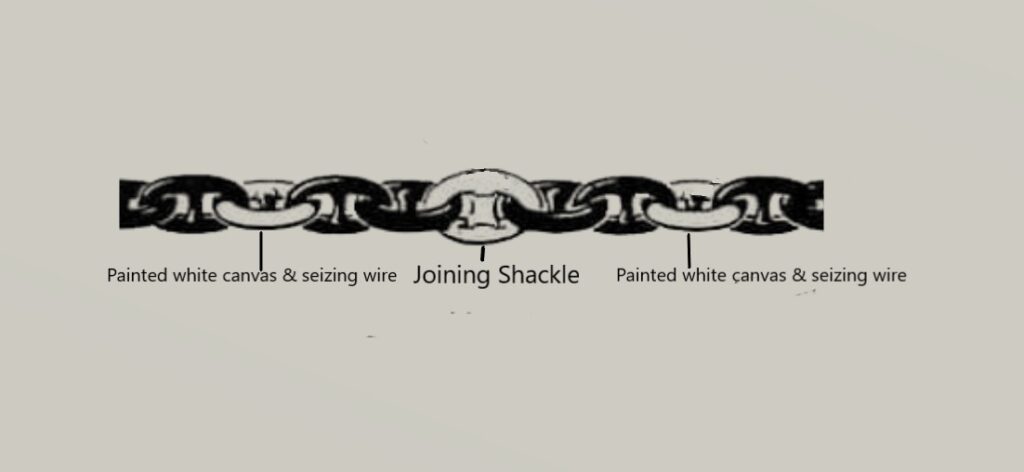
Second shackle-the second shackle is marked by seizing wire on the second studded link on both sides of the shackle.
Third shackle-the third shackle is marked by seizing wire on the third studded link on both sides of the shackle.
Fourth shackle-the fourth shackle is marked by seizing wire on the third studded link on both sides of the shackle and so on upto the last shackle
which is fixed to the bitter end.
Since seizing wire markings cannot be easily seen in the night time all joining shackles and the links which have seizing wire marking are painted white.
Some ships do not paint the joining shackle but paint all the studded links on both sides of the shackle..
Windlass
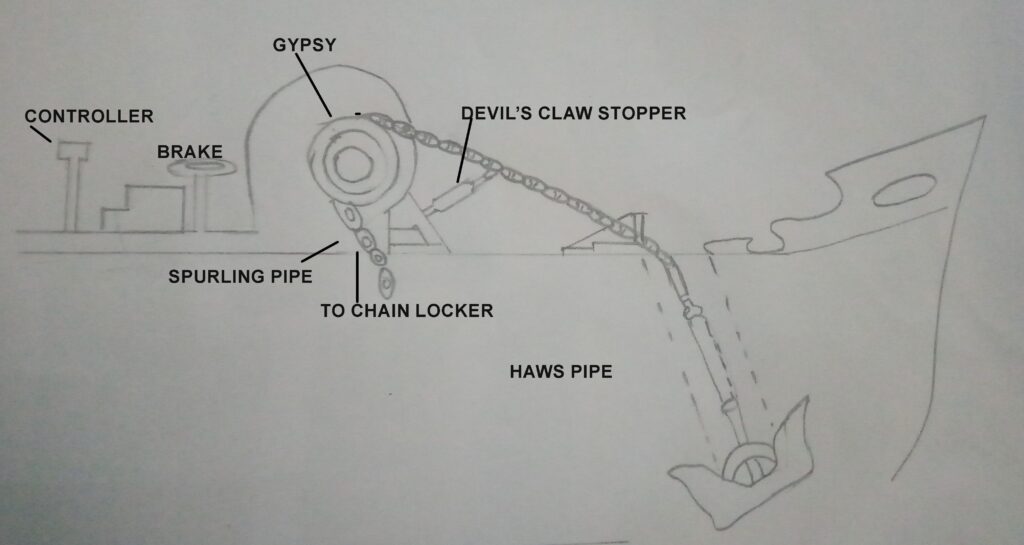
lashing/unlashing anchors.
The anchor chain must be at all times well secured during the ship is at sea.
The flukes of an anchor must rest tightly against the ship side ,there should not be any play against the ship’s side plating as the flukes can damage the ship side during rolling or pitching.
Points to remember: –
1) Windlass brake must be tighten well enough and the bow stopper is put on ,windlass is out of gear.
2) Anchor lashing with the help of wire rope with the help of bottle screw can be taken through chain links ,bottle screw to be tighten well.
3) Place the devil’s claw on the cable.
4) Spurling pipe to be covered with steel plate and additionally cover these plate with the canvas and coated with either cement or any other protective coat.
Importance of spurling pipe covers to weathertight.
The spurling pipe cover must be water tight as sea water can enter the chain locker during rough seas causing flooding in chain locker and forecastle store which results ship to down by head resulting loss to ship, cargo and crew
Process for operating the windlass system
Things required for Anchor station
Spike, a Hammer, Sledge hammer, Crowbar, Oil can filled with Lubricating oil, Goggles and a torch during night time portable VHF set.
1.Before reaching forward station engine control room to be informed for forward power well in advance
2.Before approaching the coastal area extra lashing from anchor chain and cover from spurling pipe to be removed ,just brakes and bow stopper are to keep on.
3.Gears can be engage by turning windlass slowly till gears can be engage easly
4.Once gears are on and windlass takes the weight of anchor, bow stopper to remove and brakes to open
5.Anchor is lowered upto the water level with the help of windlass gear and is in standby position for letting go
6.Once in this position the gears to be disengage and brakes to be fully tighten.
7.Once receive order to let go the anchor, only brake are required to open
Letting go the anchor
Bosun or the duty AB responsible to operate the windlass must wear goggles and PPE kit during anchor station as the anchor cable when running out may throw mud or rust etc speed causing injury,hence the protection is essential.
1.Let go the anchor by opening the brakes when let go anchor order is received.
2.Brake to be put on when the anchor hits the bottom.
3.OS or Trainee cadet to ring bell to indicate the number of shackles that have gone out. e.g. first shackle, 1 bell, 5 Shackles, 5 bells, etc.
4.Sufficient cable when paid out and the cable is sighted riding easy, bridge to be informed.
5.Compressor bar to be put on and brake to be tighten.
6.After getting order Finish with anchor stations the anchor ball to be hoist or anchor lights to put on during night.
Weighing the anchor
Weighing the anchor
Things required for Anchor station
Spike, a Hammer, Sledge hammer, Crowbar, Oil can filled with Lubricating oil, Goggles and a torch during night time.
1.Before proceeding for the anchor station engine room to inform for power and deck water well in advance.
2.Water hose to connect for washing the cable as it is hove in although cable washing arrangement is already built but still additional arrangement is required .
3.Prior to engaging gears its good practice to put on some grease and oil the moving parts.
4.Now the gears can be engage slowly and after receiving order to heave anchor the compressor bar can be removed breaks to open and start heaving anchor.
5.A standby man must be ready with running hose pipe to wash the cable as it comes up.
6.Bridge to keep informing how many cables picked up and its status.
7.When the anchor sighted aweigh (the anchor is off the ground )and the cable is vertical or up and down some more time to be given to wash the anchor from house pipe only never lean from ship’s side.
8.Now the anchor ball can be taken down or anchor light to switch off.
9.Brake to be tighten and insert the compressor bar, windlass out of gear.
10.Finish with anchor station secure the things and take extra lashings and cover Spurling pipe watertight once in open sea
How to find out if anchor is Dragging
1.Swinging circle is an imaginary circle ,which tells that if a ship is holding no matter in which direction the ship swings ship will never cross the swinging circle.
This is the radius in which the vessel swing when at anchor. The radius of the swinging circle is generally calculated as (Number of Shackles x 27.5 m + Length of the Ship in meters).
How to calculate swinging circle of the ship?
if for example (a)the distance from bridge wing to the forward(foxil) is 150 meters. (b)and the vessel is anchored with 5 shackles on deck.
Swinging circle = 150 meters + (5(shackles) x 27.5) meters
Swinging circle = 287.5 meters.
For nautical miles, divide this value by 1852 (1 Nautical mile = 1852 meters).
Swinging circle = 0.155 NM.
2.If anchor is dragging then the bow of the vessel cannot stand against the wind which results in bow movement.
3.Any extraordinary vibrations throughout the anchor chains which can be noticed.
4.The ship’s side against the wind hasn’t changed.
5.The bearing of two fixed lights or objects must not change,if it is changing, the ship is dragging.
6.By dropping the deep sea lead on to the bottom, and noting if it trails ahead of the ship.
7.If the anchor cable repeatedly comes to long stay then changes to short stay and then long stay again it means anchor is dragging.
8.There must be no slacking of chains against ship’s side against the wind turns
9.Course recorder must be check if it indicates a figure-of-eight motion locus.
10.Know position of the anchor by noting down the position of the ship when the anchor is dropped.
11.Press the MOB button on the GPS when the anchor is dropped.
12.Anchor alarm can be set for receiving early warning if anchor is dragging.
13.Monitoring the (SOG)speed of ship,any change even if the vessel is moving with the current’s flow, it indicates that anchor is dragging.
14.One more way is to put flag on the anchor chain which can be very usefull indicator If the flag falls down, there may be chance that anchor is dragging.
What actions to be taken when the vessel starts dragging its anchor
Following are some of the points which can be taken once anchor starts dragging
- Duty officer to inform master as soon as they finds that anchor is dragging, weather the ship is sailing, in port or at anchorage the master to be informed by duty officer if he finds the situation is not in his control.
- Vessel traffic system (VTS) to be informed about the situation and all other vessels in nearby vicinity to be alerted about the situation.
- Vessel to be made ready as soon as possible for immediate manoeuvring
- Forward windlass power to be kept on
- If the vessel is performing cargo operation in anchorage then cargo operations must be stopped ,all barges and floating cranes must be castoff.
- Immediately anchorage position to be changed by heaving up the anchor.
Anchor Terminology
- Anchor ‘a’ cock bill: Anchor is hanging and the flukes of anchor facing ship’s side, weight is taken by the brake and is ready for letting go.
- Anchor coming home: The anchor is drawn up when heave up by means of the windlass, the anchor is said to be coming home.
- Anchor aweigh: When the anchor is immediately clear of the bottom seabed it is said to be Anchor aweigh
- Anchor dragging: This term is used when the anchor is not holding to seabed it is said to be anchor dragging.
- Brought up : For example when the anchor is dropped and fourth joining shackle is in water and fifth joining shackle is on windlass/on the (deck).
- Bonnet cover: the covers of the spurling pipe is known as Bonnet cover .
- Clear hawse: the anchor cables is said to be clear of one another when a ship is riding to two anchors.
- Clear anchor: when the anchor is sighted clear and do not brings with itself any cable, rope or any chain picked up from the bottom.
- Compressor: is used as a brake.
- Brought up: Term is used when a vessel is riding to her anchor and cable.
- Devil’s claw: The bottle screw nut which is used to stop the anchor cable from running out.
- Foul hawse:Foul hawse happens when the anchor cable crosses each other when both cables are being used at the same time.
- Foul anchor: While picking up anchor,it may pick underwater cable,old ropes to the surface with it or fouled by its own cable.
- Gypsy: it is just a roller having a cut on it the anchor chain rides over gypsy, the link of the chain passes over through gypsy which is the vertical wheel on the windlass.
- Guillotine bar: it is a lever bar used as a brake.
- Growing: A cable is growing aft when it leads aft it tells actually how a cable is leading
- Hawse pipe: the hollow pipe where the anchor is stored.
- Lee tide: A tidal stream which is setting to leeward or downwind.
- Open hawse: When both anchors arehanging out with the cables.
- Range cable: When the cable is laid on deck or on a wharf, or in a drydock for cleaning purpose
- Nipped cable: Due to any obstruction the cable is nipped resulting vessel to change its direction sharply.
- Shortening in cable: To heave in position of a cable, so reducing the scope.
- Surge cable: When the cable is allowed to run out freely without using the brake or the windlass power.
- Snub the cable: When the brake is applied and cable is stopped from running out by applying the brake on the windlass.
- Spurling pipe: The pipe through which the cable leads to the cable locker.
- To grow: A cable is said to grow in the direction in which it leads outside the hawse pipe.
- To hang cable: to hold the cable temporarily with a stopper.
- Tide rode:When the vessel is riding head to tide.
- Up & down: The cable is said to be up and down when the cable is lying vertical to ship side makes 90° angle with the water surface,its just before anchor a weigh.
- Windlass: Machinal drum used for heaving the chain cable and for mooring hawsers.
- Walking back the anchor: To lower the anchor under power.
- Warping drum: Warping drum is fitted on both the sides of the horizontal shaft. It used for heaving the mooring hawsers.
- Weighing anchor: Weighing anchor is the operation of heaving in cable until the anchor is broken out of the bottom.
- Windrode: When the vessel is riding head to wind.
- Warping: When the ship is moved by means of hawsers without starting the engine.
- Weather tide: A tidal stream which is setting to windward or upwind.
- Yawing: Due to the wind and/or tide the vessel moves port and starboard of the anchor position
